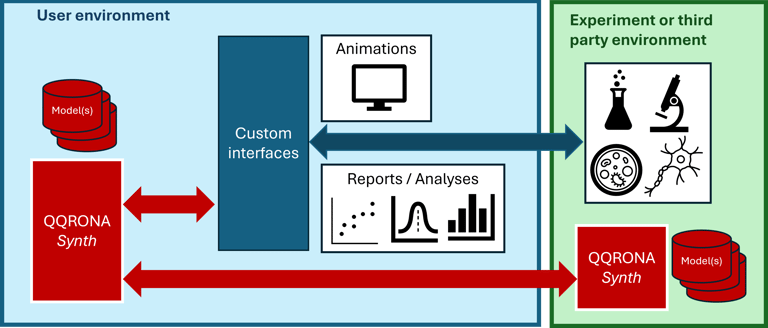The QQRONA software suite
QQRONA offers a suite of software products for developing and running QQRONA models.
QQRONASynth
The heart of the QQRONA software suite is QQRONASynth, in essence a digital computing synthesis of the analogue computer concept which is the basis of QQRONA. QQRONASynth can be run as a standalone program, delivered as an executable file along with one or more compiled QQRONA models, which constitute its “programs”. In this form, QQRONASynth can be integrated with other applications as required: for example, with an interactive user display for teaching or demonstration purposes, as illustrated by the demo videos on this site.
A QQRONA model can also be integrated with a user’s experimental environment, whether it is another computer model or a live experiment, providing realistic interaction with the experiment, or interpretation of its outputs. And, of course, QQRONA models can be connected together allowing team members or multiple teams to collaborate.
The models themselves may be developed by the QQRONA team to a user specification, and delivered in compiled form ready to be run by the QQRONASynth Executable program. However, experienced users may prefer to develop their own models using QQRONASynth Toolkit (QST).


QQRONASynth Toolkit (QST)
QST is a suite of tools for designing, building and managing QQRONA models:
An interactive graphical interface allows a user to build, configure, test and run models
The model environment is defined to provide independent and interactive inputs to the model, as well customised outputs
Experiments define how the model is run and the tests that are applied to it
Tuning strategies to refine each qcell’s configuration parameters to provide the desired behaviour
Who should use QQRONA?
QQRONA is designed to help:
Educational software publishers, to add realism and interactivity to their life science products
Lecturers and teachers, to develop engaging and effective course materials
Researchers, to deepen understanding of underlying behaviours and provide an interactive tool to support experiments
System engineers, to provide a quick and easy means to build realistic simulations as a test harness during product development
Contact us for more information.
About us
QQRONA est une initiative privée, libre de toute influence commerciale, académique ou gouvernementale. © 2025 qqrona.com. Tous droits réservés QQRONA is a private initiative, free of any commercial, academic or governmental influence. © 2025 qqrona.com. All rights reserved.
